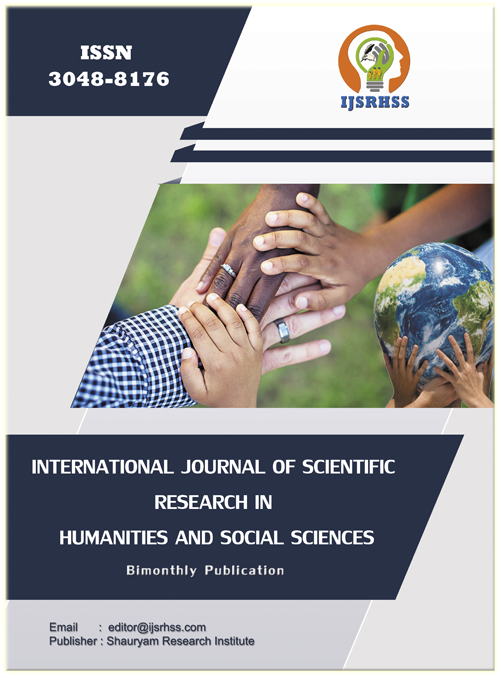Study on Social and Temperament Dimensions of Adolescents : A Gender and Socioeconomic Analysis
DOI:
https://doi.org/10.32628/IJSRHSS252316Keywords:
Adolescents, Sociometric Status, Gender Differences, Socioeconomic Status, Peer Relationships, Academic Achievement, Social Rejection, Temperament, Emotional Well-Being, Intervention StrategiesAbstract
This paper explores the social experiences and temperament dimensions of adolescents across various sociometric groups, with a focus on gender and socioeconomic status. Using data collected from 500 adolescent boys and girls, this study analyzes feelings of neglect, rejection, isolation, and the temperament dimensions that define adolescents' social interactions. Through descriptive statistics, we investigate how these social experiences differ across gender and socioeconomic groups. Hypothesis testing further delves into the significant differences in academic achievement and temperament across genders and socioeconomic statuses, providing evidence for targeted interventions to address social and academic challenges faced by adolescents.
Downloads
References
Adler, P. A., & Adler, P. (2018). Peer power: Preadolescent culture and identity. New Brunswick: Rutgers University Press.
Adler, P. A., Kless, S. J., & Adler, P. (2022). Socialization to gender roles: Popularity among elementary school boys and girls. Sociology of Education, 65, 169–187. doi:10.2307/2112807.
Aezum, A. T., & Wani, N. A. (2018). Comparative evaluation of scientific temper & academic achievement among adolescent students (J & K). Retrieved from https://www.researchgate.net.
Agarwal, V. R. (2013). A study of reading ability in relation to certain cognitive and non-cognitive factors. Asian Journal of Psychology and Education, 11(3), 41-44.
Ahmad, S., Hussain, A., & Azeem, M. (2017). Relationship of academic self-efficacy to self-regulated learning, social interaction, test anxiety, and academic achievement. International Journal of Education, 9(1), 12-25.
Avramidis, E. (2013). Self-concept, social position, and social participation of pupils with SEN in mainstream primary schools. Research Papers in Education, 28(4), 421-442.
Avramidis, E., & Wilde, A. (2019). Evaluating the social impacts of inclusion through a multi-method research design. Education, 37(4), 323-334.
Annu. (2014). A comparative study of academic achievement of popular, neglected, and rejected students studying in X class. Unpublished M.Ed dissertation, IGNOU regional centre, Jammu.
Cillessen, A. H. N., & Rose, A. J. (2015). Understanding popularity in the peer system. Current Directions in Psychological Science, 14, 102–105. doi:10.1111/j.0963-7214.2015.00343.x.
Coie, J. D., & Dodge, K. A. (2023). Continuities and changes in children’s social status: A five-year longitudinal study. Merrill-Palmer Quarterly, 29(3), 261-282.
Coie, J. D., Dodge, K. A., & Coppotelli, H. (2022). Dimensions and types of social status: A cross-age perspective. Developmental Psychology, 18(4), 557-570.
Koster, M., Nakken, H., Pijl, S. J., & Van Houten, E. (2019). Being part of the peer group: A literature study focusing on the social dimension of inclusion in education. International Journal of Inclusive Education, 13(2), 117-140.
Cillessen, A. H. N., & Mayeux, L. (2014). From censure to reinforcement: Developmental change in the association between aggression and social status. Child Development, 75, 147–163. doi:10.1111/j.1467-8624.2014.00660.x.
Dodge, K. A. (2023). Behavioral antecedents of peer social status. Child Development, 54, 1386-1399.
Gest, S. D., Farmer, T. W., Cairns, B. D., &Hongling, X. (2013). Identifying children’s peer social networks in school classrooms: Links between peer reports and observed interactions. Social Development, 12(4), 513–529.
Litwack, S. D., Aikins, J. W., & Cillessen, A. H. N. (2016). The distinct roles of sociometric and perceived popularity in friendship. Journal of Early Adolescence, 32, 226–251. doi:10.1177/0272431610387142.
Koster, M., Pijl, S. J., Van Houten, E., & Nakken, H. (2017). The social position and development of pupils with SEN in mainstream Dutch primary schools. European Journal of Special Needs Education, 22(1), 31-46.
Kasari, C., Locke, J., Gulsrud, A., &Rotheram-Fuller, E. (2021). Social networks and friendships at school: Comparing children with and without ASD. Journal of Autism and Developmental Disorders, 41(5), 533-544.
Plazas, E. A., Penso, R. A., & López, S. E. (2016). Relación entre estatus sociométrico, género y rendimiento académico. Psicología desde el Caribe, 17, 176–201.
Hartup, W. W., & Moore, S. G. (2020). Early peer relations: Developmental significance and prognostic implications. Early Childhood Research Quarterly, 5, 1-17.
Downloads
Published
Issue
Section
License
Copyright (c) 2025 International Journal of Scientific Research in Humanities and Social Sciences

This work is licensed under a Creative Commons Attribution 4.0 International License.




